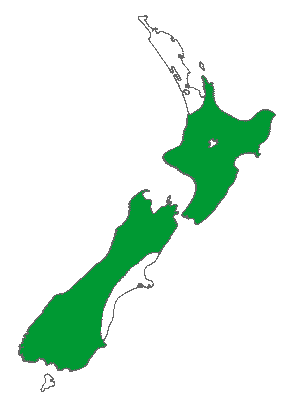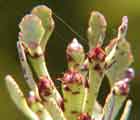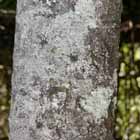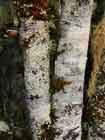
Distribution map (Metcalf 2002).

Growing shoot with reproductive structure (citation?).

Growing tip of shoot; the vestigial leaves are red. Wild plant on Mt. Tongariro [C.J. Earle, 2003.03.07].

Bark of a 15 cm diameter wild plant on Mt. Tongariro [C.J. Earle, 2003.03.07].

Tree, about 8 m tall and 15 cm dbh with several trunks, growing low on west side of Mt. Ruapehu [C.J. Earle, 2003.03.09].

Foliage on the tree shown above [C.J. Earle, 2003.03.09].

Bark of a small tree on Mt. Ruapehu; stems about 6, 8 cm diameter [C.J. Earle, 2003.03.09].

The rounded, yellow-green crowns of plants growing in habitat on Mt. Ruapehu [C.J. Earle, 2003.03.09].

Phyllocladus alpinus
Hooker 1853
Common names
Mountain toatoa (Silba 1986).
Taxonomic notes
Syn: P. aspleniifolius var. alpinus (Silba 1986), P. trichomanoides var. alpina Parlatore 1868. Type locality: Nelson. P. alpinus is polymorphic and possibly several varieties with different geographical ranges are included in the present description. Adequate comparison of New Zealand forms with those of the Tasmanian P. aspleniifolius have not been made (Allan 1961).
Description
Monoecious, strongly aromatic shrub or tree up to 9 m tall, trunk short, up to 40 cm in diameter. True leaves occur only on seedlings and occasionally on young plants. They are narrow-linear, acute, deciduous, up to 1.5 cm long, on older plants shorter. Phylloclades alternate to subopposite, rhachis short. Phylloclades of juvenile plants up to 2 cm long, deeply divided, thin, with narrow-linear segments, glaucous below; of adults thick, coriaceous, 1-2.5 cm, occasionally up to 6 cm long, 2 cm wide. Phylloclade shape various; narrow-rhomboid or spathulate, sparingly or much lobed, often elliptic to obovate, cuneate at base, apex subacute to broad-obtuse, margins crenate, leaf-denticles small. Pollen cones 5-6 mm long in fascicles of 2-5, rarely solitary, apical, with pedicels 1-2 mm long; sporophylls with small variously shaped apiculi, stems erose. Female cones arise along the margins or on the stalks of the phylloclades; receptacle of red, fleshy scales; mature heads ca. 6-7 mm diameter. Seeds nutlike, black, exserted, ovoid, compressed, ca. 2.5 mm long, obtuse; cupule white, irregularly lobed, up to 2/3 length of seed (Allan 1961, Salmon 1996).
Distribution and Ecology
New Zealand: N and S Islands from latitude 36° 50' southwards. It is found on the Coromandel Peninsula between Cape Colville and Te Aroha and from the volcanic plateau southwards between 900 m and 1,600 m to Mt Cargill, Fiordland and Southland. In South Westland and Southland it occurs down to sea level (Allan 1961, Salmon 1996). Based on data from 1119 collection localities, its climate preferences include a mean annual temperature of 8.7°C, with an average minimum in the coldest month of -0.7°C, and a mean annual precipitation of 2705 mm (Biffin et al. 2011, Table S5). Hardy to Zone 8 (cold hardiness limit between -12.1°C and -6.7°C) (Bannister and Neuner 2001).
It occurs in subalpine and scrub forest; also lowland forest in west of S Island. The wood is elastic, making the plant very wind-resistant (Allan 1961, Salmon 1996).
Remarkable Specimens
No particularly large or tall specimens are recorded. An indication of potential ages comes from one tree-ring chronology, presumably based on living tree material, covering 259 years (data on file with ITRDB).
Ethnobotany
See Conifers of New Zealand for a review of the historic role of forests in native and European cultures of New Zealand. However, there is not much evidence that this small, mostly subalpine tree was extensively used or affected by humans.
The species has proven useful in dendrochronology. Development of tree-ring chronologies apparently began with a collection in the 1970s at Pegleg Creek (S Island: 42°S, 171°E; 279 years) by Dunwiddie (1979). P. alpinus tree ring data have been used in a study of climate change in New Zealand over the last thousand years (Burrows and Greenland 1979). A survey of dendrochronological work with the species is provided by Norton and Palmer (1992).
Observations
This species is very common in the alpine and subalpine shrublands and adjacent montane forests of Tongariro National Park. It can be seen from the north trailhead up to Ketetahi Hut on the Tongariro Crossing, and on all of the walks along the Bruce Road and around Whakapapa Village on Mount Ruapehu. It is probably found on most other subalpine scrub trails in the Ruapehu area as well. The walk up to Ketetahi Hut is particularly interesting because the mountain toatoa grows as a forest tree up to about 9 m tall beneath taller trees (including Podocarpus laetus) near the start of the walk, and diminishes in stature as the track climbs upward until it is only a battered shrub growing in the company of Podocarpus nivalis and Lepidothamnus laxifolius.
Remarks
The epithet alpinus refers to the species' mostly-subalpine distribution.
Citations
Allan, H. H. 1961. Flora of New Zealand. Volume I, Indigenous Tracheophyta. Wellington: R.E. Owen Government Printer.
See also
Wardle, P. 2001. Distribution of native forest in the upper Clutha district, Otago, New Zealand. New Zealand Journal of Botany 39:435-446.
Wardle, P. 2001. Holocene forest fires in the upper Clutha district, Otago, New Zealand. New Zealand Journal of Botany 39:523-542.
The New Zealand Plant Conservation Network, accessed 2010.10.03.
Gymnosperms of New Zealand.








